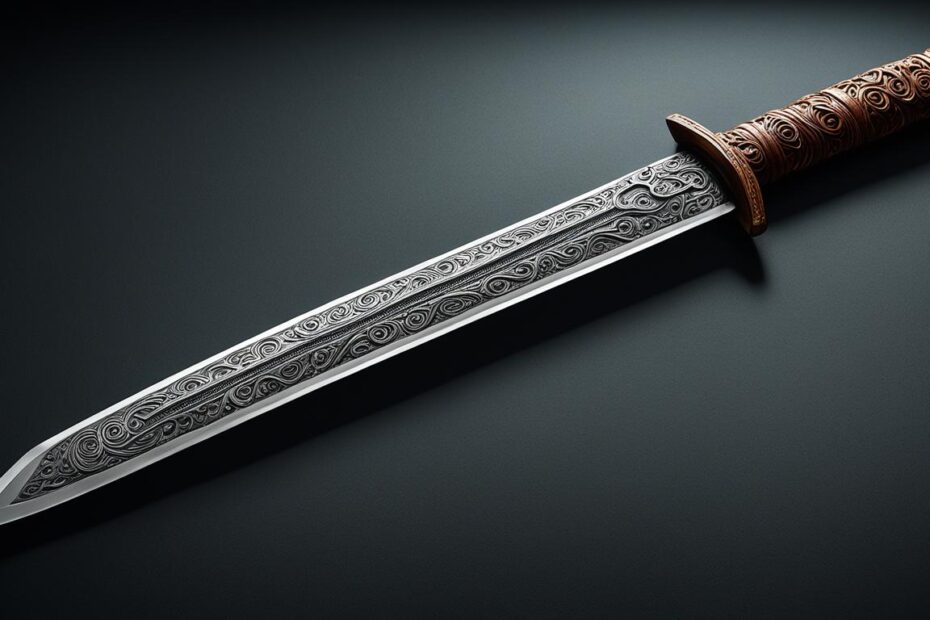Welcome to our exploration of the Sword Talibong, a traditional Filipino blade that embodies the rich heritage, exquisite craftsmanship, and vibrant martial arts culture of the Philippines. This iconic weapon holds a special place in Filipino history and continues to captivate enthusiasts around the world.
With its unique design and practical applications, the Sword Talibong is more than just a blade—it is a symbol of Filipino pride and resilience. Crafted with precision and attention to detail, the Talibong showcases the remarkable craftsmanship passed down through generations.
Undoubtedly, the Talibong has a deep-rooted history and cultural significance. Originating from the Moro culture of Mindanao, Philippines, it is closely intertwined with local martial arts traditions. The Talibong stands as a testament to the bravery and skill of Filipino warriors throughout history.
Today, the Sword Talibong continues to find relevance in modern applications. It plays an integral role in Filipino martial arts practices and is cherished by a community of dedicated practitioners. Moreover, its timeless charm has attracted collectors who seek to preserve and promote the cultural heritage embedded within this magnificent blade.
Join us as we dive deeper into the world of the Sword Talibong, exploring its design, construction, historical significance, and its resounding impact on Filipino martial arts and culture.
Understanding the Sword Talibong
When it comes to traditional Filipino weapons, the Sword Talibong holds a prominent place. Not only does it serve as a deadly weapon, but it also proves to be a versatile cutting tool in various applications. The unique design elements and meticulous construction process make the Sword Talibong a remarkable piece of craftsmanship.
As a traditional Filipino weapon, the Sword Talibong embodies the rich martial arts culture of the Philippines. Its curved blade and distinctive handle design allow for swift and precise movements, making it an ideal weapon for close combat.
But the Sword Talibong is more than just a weapon. Its expertly crafted construction makes it a highly effective cutting tool in daily tasks. From clearing vegetation to preparing meals, the Sword Talibong’s sharp blade and ergonomic handle provide a practical tool for a wide range of cutting needs.
When it comes to design, the Sword Talibong showcases intricate details that reflect the Filipino heritage. The blade’s curvature allows for efficient slicing and chopping motions while ensuring balance and control. The handle, often made from indigenous materials and adorned with decorative elements, enhances both the functionality and aesthetics of the weapon.
“The Sword Talibong is not only a martial arts weapon but also a symbol of our Filipino identity. Its design and construction reflect our rich cultural heritage and the craftsmanship that has been passed down through generations.” – Master Guro Hernandez
Crafting a Sword Talibong requires a time-honored construction process that combines traditional techniques with modern expertise. Experienced craftsmen meticulously shape the blade using high-quality steel, ensuring its durability and sharpness. The handle is carefully carved and fitted, creating a comfortable grip that allows for precise control.
Through the artistry and skill of Filipino artisans, the Sword Talibong continues to be a symbol of tradition, martial arts prowess, and cultural pride. Its design, functionality, and construction make it an exceptional weapon and cutting tool that stands the test of time.
The Sword Talibong at a Glance:
| Traditional Filipino Weapons | Cutting Tool | Design | Construction |
|---|---|---|---|
| Symbol of Filipino heritage and martial arts culture | Versatile tool for various cutting tasks | Intricate details and indigenous materials | Time-honored craftsmanship and high-quality steel |
History and Cultural Significance
The Sword Talibong holds a deep historical and cultural significance within Filipino society. Its origins can be traced back to the Moro culture of Mindanao, a region in the southern Philippines known for its rich heritage and strong martial arts traditions. The Moro people have long regarded the Talibong as a symbol of bravery, courage, and strength.
The history of the Filipino people is intertwined with the Moro culture, dating back to the pre-colonial era. Throughout the centuries, Mindanao has been a melting pot of cultural influences, including those from neighboring Southeast Asian countries. This cultural diversity is reflected in the craftsmanship and design of the Sword Talibong.
Traditionally, the Talibong was used as both a weapon and a tool for daily tasks. Its distinctive curved blade and slender profile make it a versatile cutting instrument. Moro warriors honed their martial arts skills using the Talibong, incorporating its techniques into their fighting styles.
For the Moro people, the Sword Talibong embodies their heritage and traditions. It represents their connection to the land, their ancestors, and their warrior spirit. The Talibong is not merely a weapon but a cherished cultural artifact that showcases the resilience and tenacity of the Filipino people.
Martial Arts and the Sword Talibong
The Sword Talibong plays a significant role in Filipino martial arts, commonly known as Arnis or Eskrima. These martial arts systems emphasize weapon-based combat and self-defense techniques. The Talibong is often used alongside other traditional Filipino weapons, such as the Barong and Kris, in both training and live demonstrations.
In the words of Grandmaster Floro Villabrille, a renowned practitioner of Filipino martial arts, “The Talibong is a key part of our heritage and identity. It represents the strength and skill of our warriors and reminds us of the importance of preserving our cultural traditions.”
Practitioners of Filipino martial arts train extensively with the Talibong, mastering its techniques and adapting them to modern self-defense scenarios. The sword’s balance, maneuverability, and cutting prowess make it a formidable weapon in the hands of a skilled practitioner.
The popularity of Filipino martial arts has contributed to the resurgence of interest in the Sword Talibong. Schools and organizations dedicated to preserving and promoting Filipino cultural heritage actively teach the art of Talibong fighting and aim to ensure its preservation for future generations.

| Key Points | Details |
|---|---|
| Filipino history | The Sword Talibong is deeply rooted in the history of the Filipino people, reflecting the diverse cultural influences throughout the centuries. |
| Moro culture | The Moro people of Mindanao, Philippines, have a strong martial arts tradition and regard the Talibong as a symbol of bravery and strength. |
| Mindanao | Mindanao is the region where the Talibong originated and continues to hold cultural significance among its inhabitants. |
| Martial arts | The Talibong is an integral part of Filipino martial arts, utilized in training and demonstrations alongside other traditional weapons. |
Modern Applications and Appreciation
The Sword Talibong has found a prominent place in Filipino martial arts, with practitioners incorporating its techniques and movements into their training. The agility and versatility of the Talibong make it an ideal weapon for close-quarter combat, enabling fighters to execute swift and precise strikes.
The dedication of Talibong practitioners to preserving and promoting this traditional Filipino blade has led to the formation of a vibrant community. These enthusiasts and experts gather to share their knowledge, exchange techniques, and showcase their skills. Their passion for the Talibong not only helps preserve its heritage but also encourages the next generation to appreciate the martial arts culture deeply rooted in the Philippines.
Collectors are also increasingly recognizing the cultural significance and craftsmanship of the Sword Talibong. This has led to the emergence of a thriving collector’s market, where enthusiasts seek out authentic and well-preserved Talibong blades. By collecting these prized weapons, they contribute to the preservation of Filipino heritage and ensure that future generations can appreciate the artistry and historical value of the Sword Talibong.
